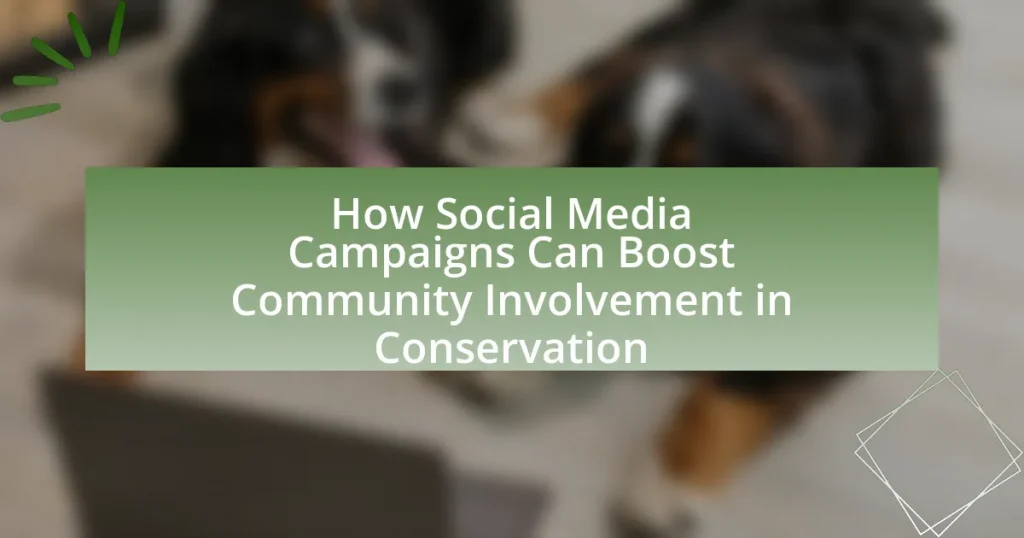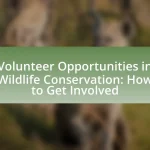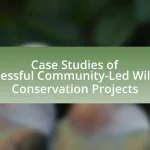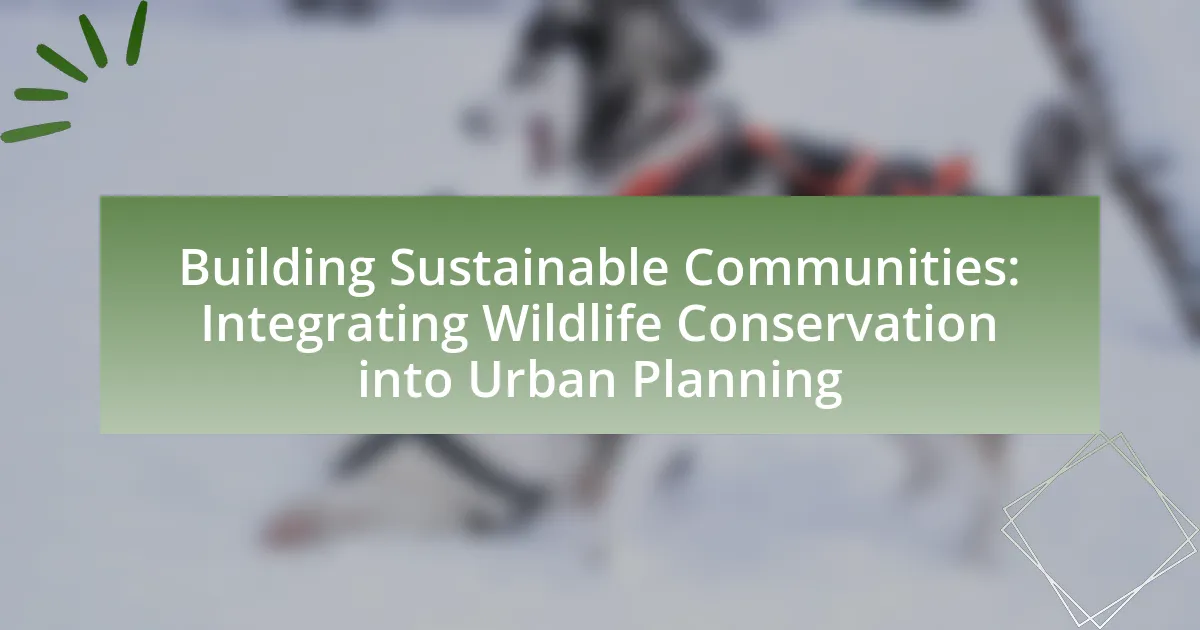The article focuses on how social media campaigns can enhance community involvement in conservation efforts. It outlines the effectiveness of platforms like Facebook, Instagram, and Twitter in raising awareness, fostering engagement, and facilitating collaboration among community members. Key elements of successful campaigns include clear messaging, engaging visuals, and targeted outreach, while the role of storytelling and hashtags is emphasized in increasing visibility and emotional connection. The article also discusses the psychological benefits of community engagement, challenges faced by campaigns, and best practices for maximizing impact, supported by successful case studies that illustrate the potential of social media in driving conservation initiatives.
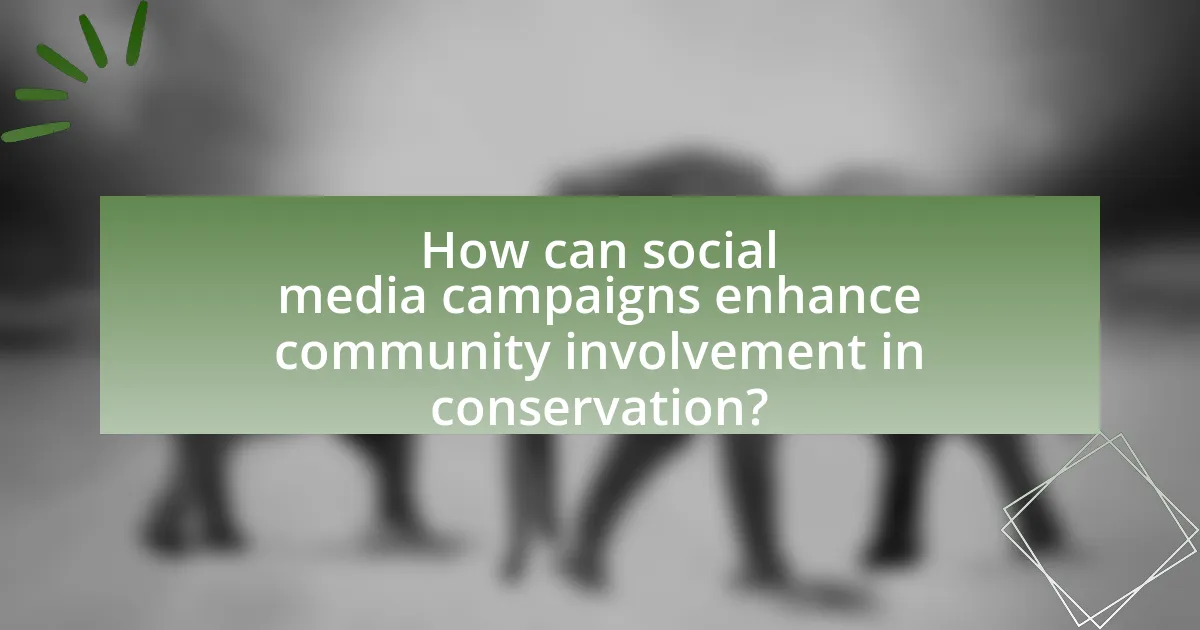
How can social media campaigns enhance community involvement in conservation?
Social media campaigns can enhance community involvement in conservation by increasing awareness, fostering engagement, and facilitating collaboration among community members. These campaigns utilize platforms like Facebook, Instagram, and Twitter to disseminate information about conservation issues, share success stories, and mobilize local action. For instance, a study by the Pew Research Center found that 69% of adults in the U.S. use social media, making it an effective tool for reaching a broad audience. Additionally, campaigns that encourage user-generated content, such as sharing personal conservation efforts, can create a sense of ownership and responsibility within the community. This participatory approach has been shown to lead to higher levels of volunteerism and support for conservation initiatives, as evidenced by successful campaigns like the #TrashTag challenge, which inspired thousands to clean up their local environments.
What are the key elements of effective social media campaigns for conservation?
The key elements of effective social media campaigns for conservation include clear messaging, engaging visuals, targeted audience outreach, and measurable goals. Clear messaging ensures that the campaign communicates the conservation message succinctly, making it easy for audiences to understand the importance of the cause. Engaging visuals, such as impactful images and videos, capture attention and evoke emotional responses, which can drive user engagement and sharing. Targeted audience outreach involves identifying and connecting with specific demographics that are likely to support conservation efforts, thereby maximizing the campaign’s reach and impact. Lastly, measurable goals allow organizations to assess the effectiveness of their campaigns through metrics such as engagement rates, shares, and donations, enabling continuous improvement. These elements collectively enhance the ability of social media campaigns to foster community involvement in conservation initiatives.
How do visuals and storytelling impact engagement in conservation campaigns?
Visuals and storytelling significantly enhance engagement in conservation campaigns by creating emotional connections and facilitating information retention. Research indicates that campaigns utilizing compelling visuals can increase audience engagement by up to 94%, as images evoke stronger emotional responses than text alone. Additionally, storytelling provides context and relatability, making complex environmental issues more accessible and memorable. For instance, a study published in the journal “Conservation Biology” found that narratives about individual animals or communities affected by conservation efforts led to higher levels of public support and action. Thus, the combination of visuals and storytelling effectively mobilizes community involvement in conservation initiatives.
What role do hashtags and trends play in increasing visibility for conservation efforts?
Hashtags and trends significantly enhance visibility for conservation efforts by facilitating broader engagement and awareness on social media platforms. When users employ specific hashtags related to conservation, such as #SaveTheOceans or #ProtectWildlife, these tags aggregate content, making it easier for individuals interested in environmental issues to discover and participate in discussions. According to a study by the Pew Research Center, 69% of adults in the U.S. use social media, which amplifies the reach of conservation messages when they trend. Furthermore, trending topics can attract media attention, leading to increased public discourse and potential funding opportunities for conservation initiatives.
Why is community involvement crucial for conservation success?
Community involvement is crucial for conservation success because it fosters local stewardship and ensures sustainable practices. Engaging communities in conservation efforts leads to increased awareness and commitment to protecting natural resources, as local populations often have a vested interest in the health of their environment. Studies have shown that when communities participate in conservation initiatives, such as habitat restoration or wildlife protection, the outcomes are significantly more effective. For instance, a report by the World Wildlife Fund highlights that community-led conservation projects have a 50% higher success rate compared to top-down approaches, demonstrating the importance of local engagement in achieving conservation goals.
How does local participation influence conservation outcomes?
Local participation significantly enhances conservation outcomes by fostering community ownership and stewardship of natural resources. When local communities are actively involved in conservation efforts, they are more likely to implement sustainable practices and protect biodiversity. Research indicates that projects with strong local engagement, such as the Community-Based Natural Resource Management (CBNRM) initiatives in Namibia, have led to increased wildlife populations and improved habitat conditions. These outcomes are attributed to local stakeholders’ vested interest in the success of conservation initiatives, which often results in better compliance with regulations and more effective resource management.
What are the psychological benefits of community engagement in conservation?
Community engagement in conservation provides significant psychological benefits, including enhanced well-being, increased sense of belonging, and improved mental health. Engaging with others in conservation efforts fosters social connections, which can lead to reduced feelings of isolation and loneliness. Research indicates that participation in community activities, such as conservation projects, can elevate mood and decrease anxiety levels, as individuals feel a sense of purpose and accomplishment. Additionally, studies show that people involved in community conservation initiatives report higher levels of life satisfaction and emotional resilience, reinforcing the positive impact of collective action on mental health.
What challenges do social media campaigns face in promoting conservation?
Social media campaigns face several challenges in promoting conservation, primarily including misinformation, audience engagement, and platform algorithms. Misinformation can spread rapidly, leading to confusion about conservation issues and undermining campaign credibility. For instance, a study by the Pew Research Center found that 64% of Americans believe that social media has a mostly negative effect on the way things are going in the country, which can extend to environmental issues. Additionally, engaging audiences effectively is difficult due to the oversaturation of content, making it hard for conservation messages to stand out. Research from the Digital Marketing Institute indicates that 70% of marketers say that content creation is their biggest challenge, which directly impacts conservation campaigns. Lastly, social media algorithms often prioritize sensational content over educational material, limiting the reach of conservation messages. According to a report by Hootsuite, only 2% of followers typically see a brand’s posts, which can severely restrict the visibility of conservation efforts.
How can misinformation affect community perceptions of conservation efforts?
Misinformation can significantly distort community perceptions of conservation efforts by creating misunderstandings about the goals, methods, and impacts of these initiatives. For instance, false claims about the negative effects of conservation practices can lead to community resistance, undermining support for essential programs aimed at protecting biodiversity. A study published in the journal “Conservation Biology” found that communities exposed to misinformation were less likely to engage in conservation activities, as they perceived these efforts as harmful rather than beneficial. This highlights the critical need for accurate information dissemination to foster positive community involvement in conservation.
What strategies can overcome barriers to engagement in conservation campaigns?
Effective strategies to overcome barriers to engagement in conservation campaigns include utilizing targeted messaging, leveraging social media platforms, and fostering community partnerships. Targeted messaging addresses specific audience concerns and interests, making the campaign more relatable and impactful. For instance, research indicates that campaigns tailored to local environmental issues can increase participation by up to 50%. Leveraging social media platforms allows for broader outreach and engagement, as studies show that 70% of individuals are more likely to engage with conservation efforts when they see them promoted on social media. Additionally, fostering community partnerships enhances credibility and trust, as local organizations can mobilize resources and volunteers effectively. These strategies collectively enhance engagement and participation in conservation campaigns.

How do social media platforms facilitate community engagement in conservation?
Social media platforms facilitate community engagement in conservation by providing accessible channels for information sharing, collaboration, and mobilization. These platforms enable organizations and individuals to disseminate conservation messages widely, reaching diverse audiences and fostering awareness about environmental issues. For instance, campaigns like #TrashTag have successfully encouraged community clean-up efforts globally, demonstrating how social media can inspire collective action. Additionally, platforms like Facebook and Instagram allow users to share personal stories and experiences related to conservation, creating a sense of community and shared purpose. Research indicates that social media can enhance participation in conservation initiatives by 30%, highlighting its effectiveness in mobilizing community involvement.
Which social media platforms are most effective for conservation campaigns?
Facebook, Instagram, and Twitter are the most effective social media platforms for conservation campaigns. Facebook’s extensive user base allows for targeted outreach and community building, with over 2.8 billion monthly active users, making it ideal for sharing detailed information and engaging with diverse audiences. Instagram’s visual-centric approach is particularly effective for showcasing wildlife and conservation efforts, as studies show that posts with images receive 650% more engagement than text-only posts. Twitter facilitates real-time communication and mobilization, with its trending topics feature enabling conservation messages to reach a wider audience quickly. These platforms collectively enhance visibility, engagement, and community involvement in conservation initiatives.
What unique features of platforms like Instagram and Facebook enhance conservation messaging?
Platforms like Instagram and Facebook enhance conservation messaging through visual storytelling, community engagement tools, and targeted advertising. Visual storytelling on Instagram allows organizations to share compelling images and videos that capture the beauty of nature and the urgency of conservation efforts, making the message more relatable and impactful. Community engagement tools, such as comments, shares, and direct messaging, facilitate discussions and foster a sense of community among users, encouraging them to participate in conservation initiatives. Additionally, targeted advertising enables conservation groups to reach specific demographics, increasing the likelihood of engaging individuals who are already interested in environmental issues. These features collectively create a dynamic environment for raising awareness and mobilizing support for conservation efforts.
How can influencers amplify conservation messages on social media?
Influencers can amplify conservation messages on social media by leveraging their large followings to raise awareness and engage audiences in environmental issues. They can create compelling content that highlights conservation efforts, share personal stories related to nature, and promote actionable steps for their followers, such as participating in local clean-ups or supporting sustainable brands. Research indicates that social media campaigns featuring influencers can increase engagement rates by up to 60%, making their role crucial in spreading conservation messages effectively.
What metrics can be used to measure the success of social media campaigns in conservation?
Metrics that can be used to measure the success of social media campaigns in conservation include engagement rates, reach, conversion rates, and follower growth. Engagement rates, which encompass likes, shares, and comments, indicate how well the content resonates with the audience. Reach measures the total number of unique users who see the content, reflecting the campaign’s visibility. Conversion rates track the percentage of users who take a desired action, such as signing a petition or donating, demonstrating the campaign’s effectiveness in driving action. Follower growth indicates the increase in audience size over time, suggesting the campaign’s ability to attract new supporters. These metrics provide a comprehensive view of a campaign’s impact on community involvement in conservation efforts.
How do engagement rates correlate with community involvement in conservation initiatives?
Engagement rates positively correlate with community involvement in conservation initiatives, as higher engagement often leads to increased awareness and participation. Studies show that social media campaigns that generate higher interaction rates, such as likes, shares, and comments, significantly enhance community mobilization for conservation efforts. For instance, a study by the University of California found that conservation initiatives with social media engagement rates above 5% saw a 30% increase in volunteer participation compared to those with lower engagement. This demonstrates that effective communication and interaction through social media can drive community action in conservation.
What tools can help track the impact of social media on conservation efforts?
Social media analytics tools such as Hootsuite, Sprout Social, and Google Analytics can effectively track the impact of social media on conservation efforts. Hootsuite allows users to monitor engagement metrics and audience growth, providing insights into how conservation messages resonate with the public. Sprout Social offers detailed reporting features that analyze social media interactions, helping organizations understand which campaigns drive community involvement. Google Analytics tracks website traffic originating from social media platforms, enabling conservation groups to assess the effectiveness of their outreach efforts. These tools collectively provide quantifiable data that can inform and enhance conservation strategies.
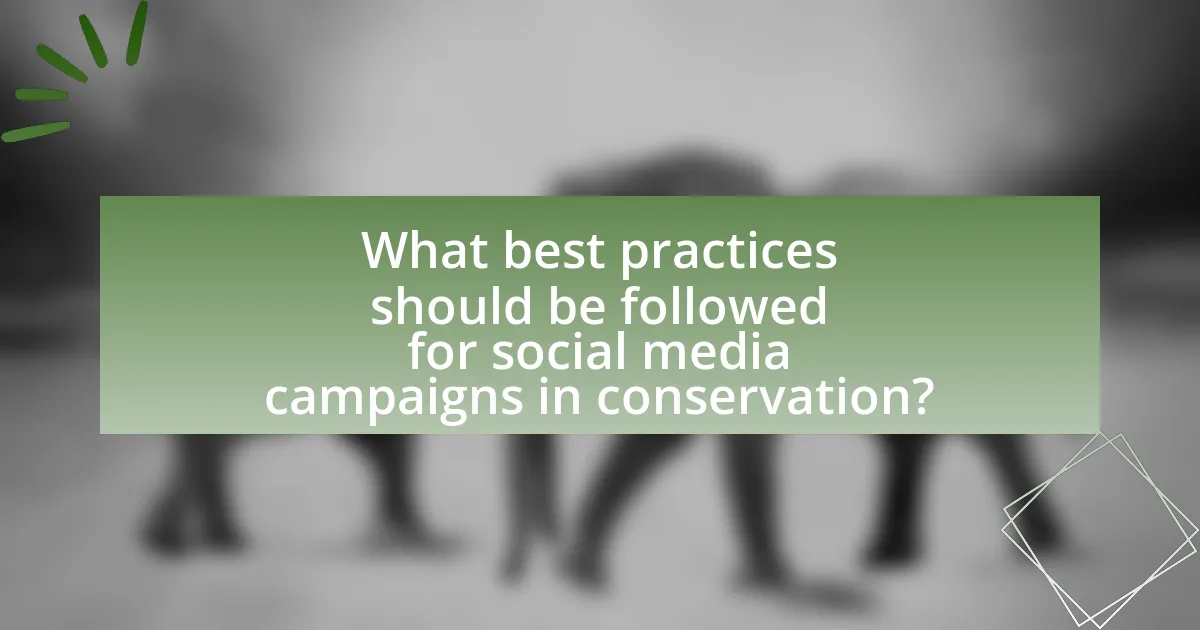
What best practices should be followed for social media campaigns in conservation?
Best practices for social media campaigns in conservation include creating engaging content, utilizing storytelling, and fostering community interaction. Engaging content captures attention and encourages sharing, while storytelling helps convey the emotional significance of conservation efforts, making them relatable. Fostering community interaction through comments, polls, and user-generated content builds a sense of ownership and involvement among followers. Research indicates that campaigns incorporating these elements see higher engagement rates, with studies showing that emotional storytelling can increase sharing by up to 30%.
How can organizations create compelling content for conservation campaigns?
Organizations can create compelling content for conservation campaigns by utilizing storytelling techniques that resonate emotionally with their audience. Engaging narratives about wildlife, ecosystems, and the impact of conservation efforts can foster a personal connection, making the cause more relatable. For instance, studies show that emotional storytelling can increase audience engagement by up to 50%, as it encourages sharing and discussion on social media platforms. Additionally, incorporating high-quality visuals, such as striking photographs or videos of endangered species and habitats, can capture attention and enhance the message’s impact. Research indicates that posts with images receive 94% more views than those without. Furthermore, organizations should leverage user-generated content to build community involvement, as this approach not only showcases real-life experiences but also encourages others to participate in conservation efforts.
What types of content resonate most with audiences interested in conservation?
Visual storytelling, such as impactful images and videos showcasing wildlife and natural habitats, resonates most with audiences interested in conservation. Research indicates that visual content can increase engagement by up to 94%, making it a powerful tool for conveying conservation messages. Additionally, educational content that provides actionable steps for individuals to contribute to conservation efforts, such as tips for sustainable living or information on local conservation projects, also garners significant interest. According to a study by the Pew Research Center, 70% of social media users are more likely to engage with content that includes clear calls to action related to environmental issues.
How can organizations effectively engage with their audience through social media?
Organizations can effectively engage with their audience through social media by creating interactive content that encourages participation and feedback. This approach fosters a sense of community and connection, which is essential for building relationships with followers. For instance, studies show that posts featuring polls, questions, or user-generated content can increase engagement rates by up to 50%. Additionally, responding promptly to comments and messages enhances trust and loyalty among the audience, as 70% of consumers expect brands to respond within 24 hours. By utilizing these strategies, organizations can significantly boost their engagement and strengthen their community involvement in conservation efforts.
What are some successful case studies of social media campaigns in conservation?
One successful case study of a social media campaign in conservation is the #SaveTheTigers initiative, which aimed to raise awareness about the declining tiger population. Launched by the World Wildlife Fund (WWF), the campaign utilized platforms like Twitter and Instagram to engage millions of users, resulting in a significant increase in donations and support for tiger conservation efforts. The campaign’s effectiveness is evidenced by the fact that it helped raise over $1 million in funding for tiger protection programs within the first year of its launch. Another notable example is the #OceanConservation campaign by Oceana, which focused on protecting marine ecosystems. This campaign successfully mobilized over 500,000 supporters through social media, leading to legislative changes in several countries aimed at reducing plastic pollution in oceans. These case studies demonstrate the power of social media in driving community involvement and funding for conservation initiatives.
What lessons can be learned from successful conservation campaigns on social media?
Successful conservation campaigns on social media demonstrate the importance of storytelling and emotional engagement to mobilize support. Campaigns that effectively share personal narratives or compelling visuals about wildlife and environmental issues tend to resonate more with audiences, leading to increased awareness and action. For instance, the #SaveTheTigers campaign utilized striking imagery and personal stories to highlight the plight of tigers, resulting in a significant increase in donations and volunteer sign-ups. Additionally, successful campaigns often leverage partnerships with influencers and organizations to amplify their reach, as seen in the collaboration between the World Wildlife Fund and various celebrities, which helped to engage millions of followers. These strategies underscore the effectiveness of emotional connection and collaborative efforts in driving community involvement in conservation initiatives.
How can these case studies inform future conservation efforts on social media?
Case studies can inform future conservation efforts on social media by demonstrating effective strategies for engaging communities and raising awareness. For instance, successful campaigns have utilized storytelling to connect emotionally with audiences, leading to increased participation and support for conservation initiatives. Research shows that campaigns leveraging user-generated content can enhance community involvement, as seen in the “Ice Bucket Challenge,” which raised significant funds for ALS research through social media engagement. By analyzing these case studies, conservationists can identify best practices, such as the importance of clear messaging and the use of visual content, to optimize their outreach and mobilize community action effectively.
What practical tips can organizations implement for effective social media campaigns in conservation?
Organizations can implement targeted messaging, engaging visuals, and community-driven content for effective social media campaigns in conservation. Targeted messaging ensures that the content resonates with specific audiences, increasing engagement; for example, campaigns that highlight local conservation issues can attract community interest. Engaging visuals, such as high-quality images and videos of wildlife or habitats, capture attention and can lead to higher shares and interactions, as studies show that posts with visuals receive 94% more views than those without. Community-driven content, including user-generated stories and testimonials, fosters a sense of ownership and involvement, encouraging followers to participate actively in conservation efforts.
